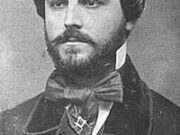A brigadier general in the Confederate army, Alfred Iverson Jr. captured the highest-ranking Union officer ever taken prisoner during the Civil War (1861-65), Major General George Stoneman. Iverson led forces in the Battles of Gaines’ Mill and Chancellorsville in Virginia, Antietam in Maryland, and Gettysburg in Pennsylvania.
Iverson was born in Clinton, in Jones County, on February 14, 1829. When he was a year old, his family moved to Columbus. His father, Alfred Iverson Sr., was a superior court judge in Muscogee County and served in the state senate, the U.S. House of Representatives, and the U.S. Senate. The younger Iverson married twice in his life, first to Harriet Harris Hutchins, with whom he had two daughters, and second to Adela Branham.
When the Mexican War (1846-48) broke out in 1846, Iverson was a seventeen-year-old enrolled in the Tuskegee Military Institute in Alabama. He joined a Georgia volunteer cavalry regiment and fought with distinction in the war, becoming a second lieutenant. As a first lieutenant in the U.S. First Cavalry Regiment, he took part in attempts to put down clashes between pro- and anti-slavery advocates in the new Kansas Territory in the mid-1850s; later he took part in cavalry actions against the Kiowas and Comanches.
When the Civil War started, Iverson resigned as a U.S. Army lieutenant, became a captain in the Twentieth North Carolina Cavalry Regiment, and recruited several volunteer companies. After being made a colonel, Iverson fought at Gaines’ Mill in Virginia during the Seven Days’ Battles in June 1862 and later was wounded. He also took part in the Maryland campaigns and was promoted to brigadier general after honorable service at Antietam. A decision by his superior, Major General Robert E. Rodes, to press Union troops near Gettysburg, Pennsylvania, without first scouting led to a disastrous attack on Iverson’s troops. Union soldiers rose up from behind a stone wall, simultaneously attacking Iverson’s front and flank; Iverson incurred 500 casualties, and three regiments surrendered after the ambush. Thus began the first of three days of Gettysburg battles that would spell the end of the Confederates’ tactical superiority.
Iverson was reassigned to the home guard in Rome, Georgia, and later was given command of a cavalry brigade under General Joseph Wheeler. While General William T. Sherman was taking Atlanta, Major General George Stoneman and 2,500 Union cavalry were on their way to eliminate the Macon and Western Railroad south of the city and thus cut off Atlanta’s supply line. On July 31, 1864, Iverson, with only 1,300 cavalrymen, met Stoneman’s cavalry in Jones County, near Macon. Iverson tricked Stoneman into thinking he led a much larger contingent and captured the major general and 600 of his men.
After the Civil War Iverson lived in Macon and then moved to Florida to develop an orange plantation. He returned to Atlanta later to live with his daughter’s family and died there in 1911. Iverson is buried in Oakland Cemetery, where a plaque marks his grave.




